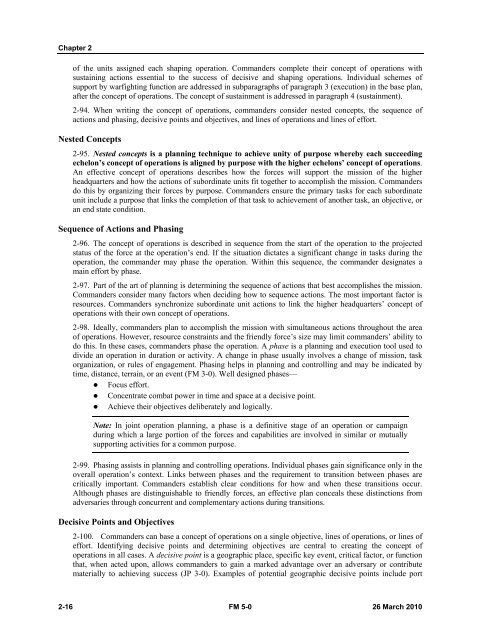FM 5-0, The Operations Process - Federation of American Scientists
FM 5-0, The Operations Process - Federation of American Scientists
FM 5-0, The Operations Process - Federation of American Scientists
You also want an ePaper? Increase the reach of your titles
YUMPU automatically turns print PDFs into web optimized ePapers that Google loves.
Chapter 2<br />
<strong>of</strong> the units assigned each shaping operation. Commanders complete their concept <strong>of</strong> operations with<br />
sustaining actions essential to the success <strong>of</strong> decisive and shaping operations. Individual schemes <strong>of</strong><br />
support by warfighting function are addressed in subparagraphs <strong>of</strong> paragraph 3 (execution) in the base plan,<br />
after the concept <strong>of</strong> operations. <strong>The</strong> concept <strong>of</strong> sustainment is addressed in paragraph 4 (sustainment).<br />
2-94. When writing the concept <strong>of</strong> operations, commanders consider nested concepts, the sequence <strong>of</strong><br />
actions and phasing, decisive points and objectives, and lines <strong>of</strong> operations and lines <strong>of</strong> effort.<br />
Nested Concepts<br />
2-95. Nested concepts is a planning technique to achieve unity <strong>of</strong> purpose whereby each succeeding<br />
echelon’s concept <strong>of</strong> operations is aligned by purpose with the higher echelons’ concept <strong>of</strong> operations.<br />
An effective concept <strong>of</strong> operations describes how the forces will support the mission <strong>of</strong> the higher<br />
headquarters and how the actions <strong>of</strong> subordinate units fit together to accomplish the mission. Commanders<br />
do this by organizing their forces by purpose. Commanders ensure the primary tasks for each subordinate<br />
unit include a purpose that links the completion <strong>of</strong> that task to achievement <strong>of</strong> another task, an objective, or<br />
an end state condition.<br />
Sequence <strong>of</strong> Actions and Phasing<br />
2-96. <strong>The</strong> concept <strong>of</strong> operations is described in sequence from the start <strong>of</strong> the operation to the projected<br />
status <strong>of</strong> the force at the operation’s end. If the situation dictates a significant change in tasks during the<br />
operation, the commander may phase the operation. Within this sequence, the commander designates a<br />
main effort by phase.<br />
2-97. Part <strong>of</strong> the art <strong>of</strong> planning is determining the sequence <strong>of</strong> actions that best accomplishes the mission.<br />
Commanders consider many factors when deciding how to sequence actions. <strong>The</strong> most important factor is<br />
resources. Commanders synchronize subordinate unit actions to link the higher headquarters’ concept <strong>of</strong><br />
operations with their own concept <strong>of</strong> operations.<br />
2-98. Ideally, commanders plan to accomplish the mission with simultaneous actions throughout the area<br />
<strong>of</strong> operations. However, resource constraints and the friendly force’s size may limit commanders’ ability to<br />
do this. In these cases, commanders phase the operation. A phase is a planning and execution tool used to<br />
divide an operation in duration or activity. A change in phase usually involves a change <strong>of</strong> mission, task<br />
organization, or rules <strong>of</strong> engagement. Phasing helps in planning and controlling and may be indicated by<br />
time, distance, terrain, or an event (<strong>FM</strong> 3-0). Well designed phases—<br />
• Focus effort.<br />
• Concentrate combat power in time and space at a decisive point.<br />
• Achieve their objectives deliberately and logically.<br />
Note: In joint operation planning, a phase is a definitive stage <strong>of</strong> an operation or campaign<br />
during which a large portion <strong>of</strong> the forces and capabilities are involved in similar or mutually<br />
supporting activities for a common purpose.<br />
2-99. Phasing assists in planning and controlling operations. Individual phases gain significance only in the<br />
overall operation’s context. Links between phases and the requirement to transition between phases are<br />
critically important. Commanders establish clear conditions for how and when these transitions occur.<br />
Although phases are distinguishable to friendly forces, an effective plan conceals these distinctions from<br />
adversaries through concurrent and complementary actions during transitions.<br />
Decisive Points and Objectives<br />
2-100. Commanders can base a concept <strong>of</strong> operations on a single objective, lines <strong>of</strong> operations, or lines <strong>of</strong><br />
effort. Identifying decisive points and determining objectives are central to creating the concept <strong>of</strong><br />
operations in all cases. A decisive point is a geographic place, specific key event, critical factor, or function<br />
that, when acted upon, allows commanders to gain a marked advantage over an adversary or contribute<br />
materially to achieving success (JP 3-0). Examples <strong>of</strong> potential geographic decisive points include port<br />
2-16 <strong>FM</strong> 5-0 26 March 2010















